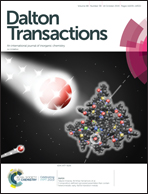Synthesis and biological properties of tetranuclear ruthenium complexes containing the bis[4(4′-methyl-2,2′-bipyridyl)]-1,7-heptane ligand†
Abstract
Linear and non-linear tetranuclear ruthenium(II) complexes containing the bridging ligand bis[4(4′-methyl-2,2′-bipyridyl)]-1,7-heptane have been synthesised and their biological properties examined. The minimum inhibitory concentrations (MIC) and the minimum bactericidal concentrations (MBC) of the ruthenium(II) complexes were determined against six strains of bacteria: Gram-positive Staphylococcus aureus (S. aureus) and methicillin-resistant S. aureus (MRSA); and the Gram-negative Escherichia coli (E. coli) strains MG1655, APEC, UPEC and Pseudomonas aeruginosa (P. aeruginosa). The results showed that both tetranuclear complexes had significant antimicrobial activity, with the non-linear (branched) species (Rubb7-TNL) having slightly higher activity than the corresponding linear analogue (Rubb7-TL). The corresponding toxicity against three eukaryotic cell lines – BHK (baby hamster kidney), Caco-2 (heterogeneous human epithelial colorectal adenocarcinoma) and Hep-G2 (liver carcinoma) – have also been determined. Interestingly, both Rubb7-TNL and Rubb7-TL were as toxic to the eukaryotic cells as they were to the bacteria, a rarity for kinetically-inert cationic polypyridylruthenium(II) complexes, and exhibited lower IC50 values than cisplatin over 24-, 48- or 72-hour incubation times. Fluorescence spectroscopy was used to study the binding of the ruthenium complexes with human serum albumin (HSA). Rubb7-TNL and Rubb7-TL exhibited strong HSA binding, with equilibrium binding constants in the order of 107 M−1. Confocal microscopy was used to examine the cellular localisation of Rubb7-TNL in BHK cells. The results indicated that the ruthenium complex localised in the nucleolus. Significant accumulation was also observed in the cytoplasm, but not in the mitochondria. Taken together, the results of this study suggest that Rubb7-TNL is an unlikely candidate as an antimicrobial agent, but may have potential as an anticancer drug.
![Graphical abstract: Synthesis and biological properties of tetranuclear ruthenium complexes containing the bis[4(4′-methyl-2,2′-bipyridyl)]-1,7-heptane ligand](/en/Image/Get?imageInfo.ImageType=GA&imageInfo.ImageIdentifier.ManuscriptID=C9DT03221E&imageInfo.ImageIdentifier.Year=2019)


 Please wait while we load your content...
Please wait while we load your content...